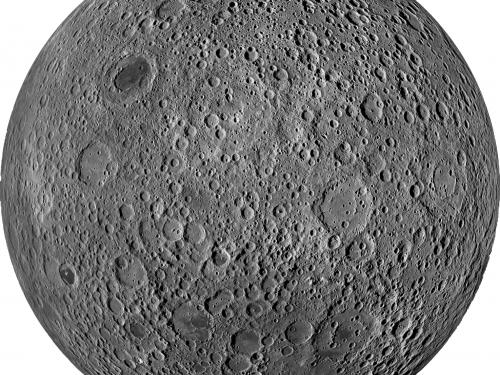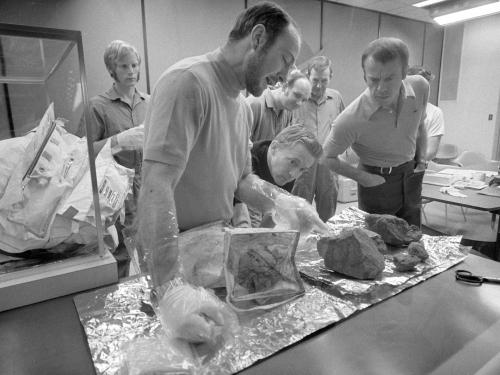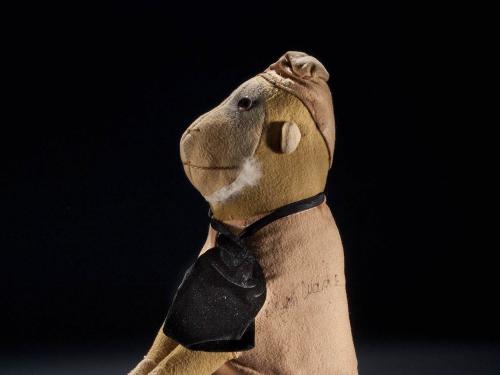
Stories of daring, stories of technological feats, stories of prevailing against the odds ... these are the stories we tell at the National Air and Space Museum. Dive in to the stories below to discover, learn, and be inspired.
Showing 1221 - 1230 of 1761

March 03, 2016
I recently shared that we uncovered handwritten notes and markings inside the Apollo 11 Command Module Columbia—the spacecraft that carried astronauts Armstrong, Collins, and Aldrin into lunar orbit and home on their historic voyage of July 1969. As part of our collaboration with the Smithsonian’s Digitization Program Office to create a detailed 3D model of the spacecraft, we had access to previously inaccessible areas for the first time in many years. We found notes written on a number of locker doors and even a small calendar used to check off days of the mission. We did our best to imagine the circumstances surrounding the creation of these markings. In the weeks that have passed, I have been working with an extraordinary team of experts to see what we can learn about each of the markings we documented, especially the more technical numerical entries. Today, we are posting the Apollo Flight Journal (AFJ) website, a detailed account of all the information we’ve gathered so far.

March 02, 2016
No one could say Ruth Law was a novice. She had been flying since 1912. She was the first woman to fly at night, in a biplane purchased from Orville Wright.

February 27, 2016
I met Eric Brown in April 2013 at the Royal Air Force Club in Piccadilly, London. Enthusiastically, he had agreed to this meeting to answer my research questions. The first thing I noticed was how agile and slim he looked—barely 5 ft. 7 in. tall, he had the figure of a much younger man and walked the stairs up to the restaurant with the elegance and energy of a man much younger than the 94-year-old man he was at that time. While listening to him, I was aware that I talked to a true legend: the experimental test pilot who had flown 487 different types of aircraft, more than any pilot in history, and the British Royal Navy officer who had landed more aircraft on carriers than anybody else in the world, a total of 2,407 landings, among them even jet-propelled aircraft.

February 26, 2016
Scientific images can rival those of the most talented artists, a fact that is now on display in A New Moon Rises at our Museum in Washington, DC. Take, for example, an image of Reiner Gamma, a beautiful and strange feature on the Moon that looks as though a tadpole has been painted across the flat surface of Oceanus Procellarum. The image demonstrates the phenomenon of lunar swirls – bright patterns that some scientists believe may result from the solar wind striking the lunar soil. A localized magnetic field anomaly may have given this swirl its peculiar shape. The photo is densely packed with scientific information.

February 24, 2016
Almost a year ago, the Museum announced that it had acquired papers and artifacts of Arthur C. Clarke (1917-2008), renowned science fiction author and futurist. Now we can share that the Archives has completed processing the collection and it is open for research. As we discussed in blogs last year, Clarke was a seminal figure of the 20th century, with his influence still evident in today’s science fiction literature; in the continuing, lively cultural interest in futurism; and, of course, in movies. His collection does what we hope for from any collection of a well-known, highly accomplished individual: to see into his or her processes of creativity and the network of family, friends, and peers that shaped their world.

February 17, 2016
Training underwater for extravehicular activity (EVA)—popularly known as spacewalking—is now critical for preparing astronauts to work in weightlessness. But when cosmonauts and astronauts first ventured outside their spacecraft 50 years ago, in 1965 and 1966, they had no such training. Spacewalking did not appear difficult, nor did space program officials think that underwater work was needed. In the United States, it took Eugene Cernan’s June 1966 Gemini IX EVA to change attitudes. Fighting against his pressurized suit, while trying to do work without adequate handholds and footholds, Cernan quickly became exhausted and overheated. Only afterward did NASA Manned Spacecraft Center in Houston reach out to a tiny company outside Baltimore: Environmental Research Associates, Inc. (ERA). Funded by another agency center, it had been experimenting with EVA simulation in a rented school pool on nights, holidays, and weekends. That project became the foundation for Houston’s first underwater training facility.

February 15, 2016
Lots of museums and historical institutions have letters from George Washington and Abraham Lincoln in their collection, but why would a museum dedicated to aviation, space exploration, and planetary science?

February 11, 2016
During the course of a project to produce a detailed 3D model of the Apollo 11 Command Module Columbia, we were able to observe and record some hand-written notes and markings in areas of the spacecraft that have been hidden from view for more than 40 years.

February 09, 2016
On Thursday, February 4, the world lost the last of the Apollo 14 astronauts. Edgar Dean Mitchell, U.S. Navy test pilot and the sixth person to walk on the Moon, passed away in his sleep near his Florida home at the age of 85. Though it was his only flight into space, Apollo 14 provided the rather insightful Mitchell with an opportunity to test the bounds of the human mind in ways sometimes only he knew of at the time. Characterized later as the “Overview Effect,” he described the space travel experience as one that shifted his own beliefs about human existence, though having an openness to such a change was always a part of Mitchell’s way of life.

February 08, 2016
Happy Chinese New Year! To celebrate the Year of the Monkey we wanted to share one special monkey from our collection. Maggie, a stuffed spider monkey, has an especially interesting story.